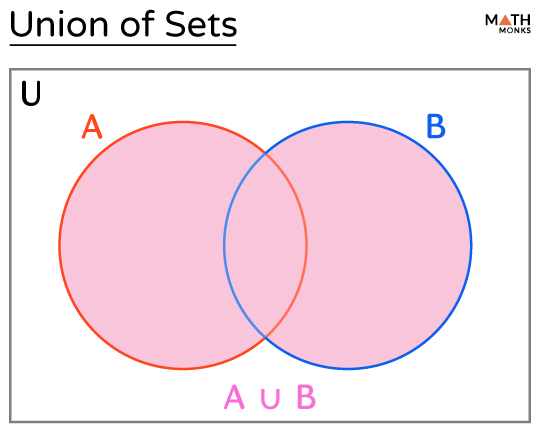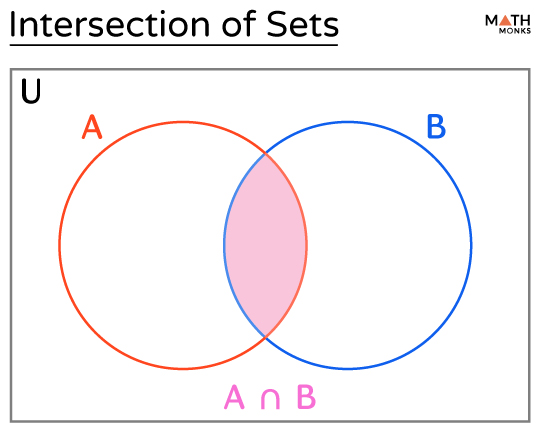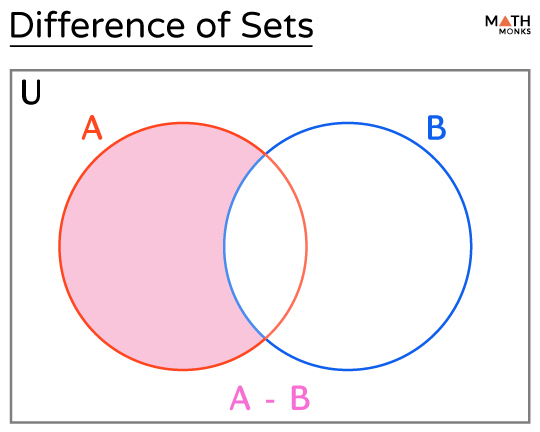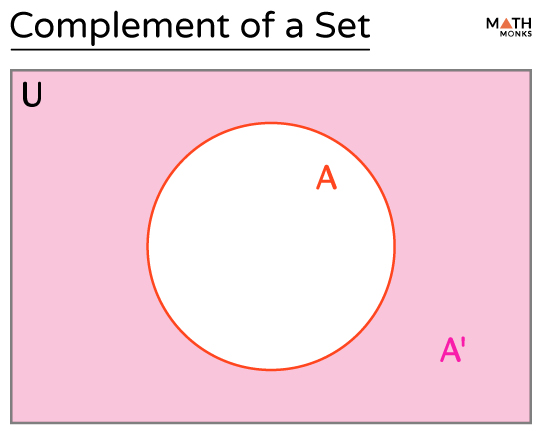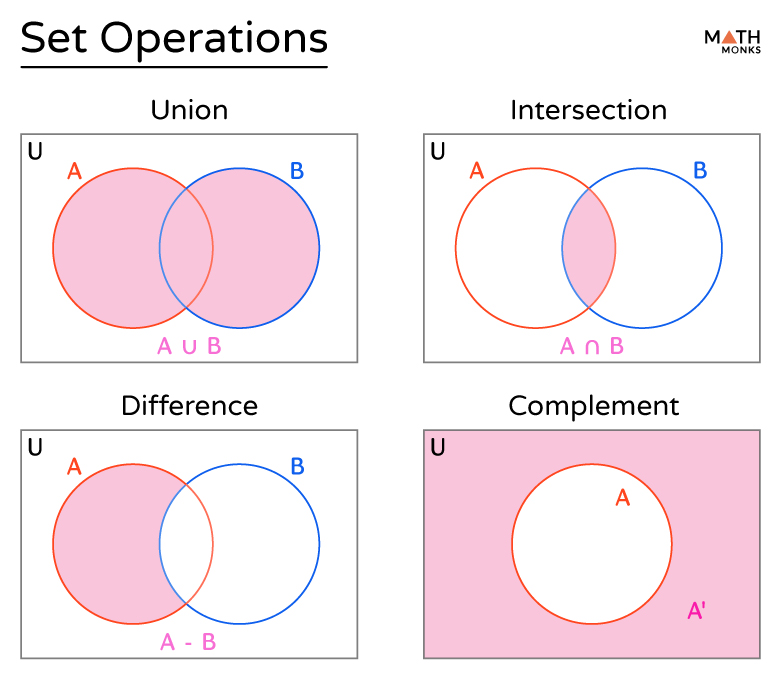Sets operation establishes a relation between two or more given sets. Each operation is represented with a distinct symbol.
There are four major types of set operations.
Union
If ‘A’ and ‘B’ are two sets, then the union of sets A and B is a set containing all the elements present either in A or in B.
Mathematically, it is represented by the symbol ‘⋃’. A ⋃ B is as read as A ‘union’ B
If A ⋃ B = {x | x ∈ A or x ∈ B}
Here, ‘x’ is the element of sets A and B.
For example,
If A = {10, 11, 12, 13, 14} and B {26, 27}, then the union of sets is A ⋃ B = {10, 11, 12, 13, 14, 26, 27}
If A = {5, 7, 9, 11} and B = {7, 9, 11, 13}, then the union of sets is A ⋃ B = {5, 7, 9, 11, 13}
The shaded part in the Venn diagram shows the union of sets A and B.
Intersection
If ‘A’ and ‘B’ are two sets, the intersection of sets A and B is a set containing all elements common to both A and B.
Mathematically, it is represented by the symbol ‘∩’. A ∩ B is as read as A ‘intersection’ B.
If A ∩ B = {x | x ∈ A and x ∈ B}
Here, ‘x’ is the common element of sets A and B.
The intersection of sets A and B, A ∩ B, is written by the formula
n(A ∩ B) = n(A) + n(B) – n(A ⋃ B)
here,
n(A) = cardinality of set A,
n(B) = cardinality of set B,
n(A ⋃ B) = cardinal number for the union of sets A and B.
For example, if A = {10, 12, 14} and B = {12, 14, 16}, then A ∩ B = {12, 14}.
The shaded part in the Venn diagram shows the intersection of sets A and B.
Difference
If ‘A’ and ‘B’ are two sets, then the difference between sets A and B is a set that consists of elements present in A but not in B.
Mathematically, it is represented by the symbol ‘-’ and is written as A – B.
For example, if A = { 4, 5, 6, 7} and B = {4, 5}, then the difference of set A and set B is A – B = {6, 7}
The difference between set A and set B can also be expressed as the intersection of set A with the complement of set B. That is, A − B = A ∩ B′
The shaded part in the Venn diagram shows the difference between sets A and B.
Complement
If ‘U’ is a universal set and ‘A’ is any subset of ‘U,’ the complement of set A, represented by the symbol A′ or Ac, is the set of all the elements in the universal set ‘U’ that are not present in set A.
Mathematically, it is written as
A′ = {x | x ∈ U and x ∉ A}
For example, if U = {1, 2, 3, 4, 5, 6, 7, 8, 9, 10} and A = {2, 4, 6, 8, 10}, then the complement of A is A’ = {1, 3, 5, 7, 9}
The shaded part in the Venn diagram shows the complement of ‘A’
Here is the list of all the four set operations shown using Venn diagrams.
Properties
Set operations follow the same properties as any numerical operations:
Commutative
If ‘A’ and ‘B’ are two sets, then
Union: The union of sets is always commutative, which means A ⋃ B = B ⋃ A
Intersection: The intersection of sets is always commutative, which means A ∩ B = B ∩ A
Associative
If ‘A,’ ‘B,’ and ‘C’ are any three sets, then
Union: The union of sets is always associative, which means (A ⋃ B) ⋃ C = A ⋃ (B ⋃ C)
Intersection: The intersection of sets is always associative, which means (A ∩ B) ∩ C = A ∩ (B ∩ C)
Distributive
Union over Intersection: The distributive property holds for the union over intersection, which is represented as A ⋃ (B ∩ C) = (A ⋃ B) ∩ (A ⋃ C)
Intersection over Union: The distributive property also holds for the intersection over union, which is represented as A ∩ (B ⋃ C) = (A ∩ B) ⋃ (A ∩ C)
Identity
Union: A ⋃ ɸ = A, where ɸ is the null set.
Intersection: A ∩ U = A, where U is the universal set.
Complement
Union: A ⋃ A′ = U, where U is the universal set.
Intersection: A ∩ A′ = ɸ, where ɸ is the null set.
Absorption
Union over Intersection: If ‘A’ and ‘B’ are two sets, then A ⋃ (A ∩ B) = A
Intersection over Union: If ‘A” and ‘B’ are two sets, then A ∩ (A ⋃ B) = A
Idempotent
Union: A ⋃ A = A, the union of a set with itself produces the original set.
Intersection: A ∩ A = A, the intersection of a set with itself produces the original set.
De-Morgan’s Law
It states that if ‘A’ and ‘B’ are two sets, then it follows the relation
(A ⋃ B)′ = A′ ∩ B′ and (A ∩ B)′ = A′ ⋃ B′
Solved Examples
![]() If A = {5, 6, a, e, f}, B = {1, 2, 3, 4, b, c, d}, and U = {0, 1, 2, 3, 4, 5, 6, 7, a, b, c, d, e, f, g}, find the solutions using the given operations on sets.
If A = {5, 6, a, e, f}, B = {1, 2, 3, 4, b, c, d}, and U = {0, 1, 2, 3, 4, 5, 6, 7, a, b, c, d, e, f, g}, find the solutions using the given operations on sets.
a) A ⋃ B
b) B′
c) A′
d) A ∩ B
e) A – B
Solution:
![]()
Given A = {5, 6, a, e, f}, B = {1, 2, 3, 4, b, c, d} and U = {0, 1, 2, 3, 4, 5, 6, 7, a, b, c, d, e, f, g}
Thus,
a) A ⋃ B = {5, 6, a, e, f} ⋃ {1, 2, 3, 4, b, c, d} = {1, 2, 3, 4, 5, 6, a, b, c, d, e, f}
b) B′ = U – B
= {0, 1, 2, 3, 4, 5, 6, 7, a, b, c, d, e, f, g} – {1, 2, 3, 4, b, c, d}
= {0, 5, 6, 7, a, e, f, g}
c) A′ = U – A
= {0, 1, 2, 3, 4, 5, 6, 7, a, b, c, d, e, f, g} – {5, 6, a, e, f}
= {0, 1, 2, 3, 4, 7, b, c, d, g}
d) A ∩ B = {5, 6, a, e, f} ∩ {1, 2, 3, 4, b, c, d} = ɸ
e) A – B = A ∩ B′
= {5, 6, a, e, f} ∩ {0, 5, 6, 7, a, e, f, g}
= {5, 6, a, e, f}
![]() In a school, every student likes either English or Mathematics or both. It was found that 120 students liked English, 100 students liked Mathematics, and 45 students liked both. Represent the situation in the Venn diagram and find how many students were there in the school using the set operation formula.
In a school, every student likes either English or Mathematics or both. It was found that 120 students liked English, 100 students liked Mathematics, and 45 students liked both. Represent the situation in the Venn diagram and find how many students were there in the school using the set operation formula.
Solution:
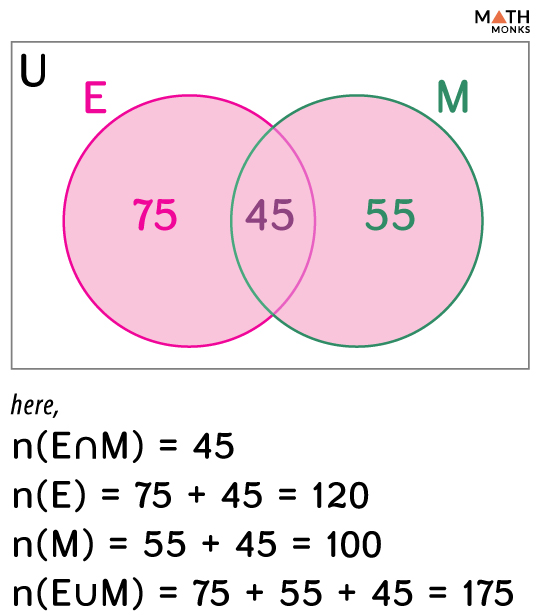
Let the number of students who liked English be n(E) and the number of students who liked Mathematics be n(M).
Given n(E) = 120, n(M) = 100, and n(E ∩ M) = 45
As we know, for two sets, ‘E’ and ‘M,’
n(E ∩ M) = n(E) + n(M) – n(E ⋃ M)
⇒ 45 = 120 + 100 – n(E ⋃ M)
⇒ n(E ⋃ M) = 120 +100 – 45
⇒ n(E ⋃ M) = 175

